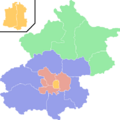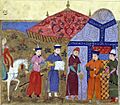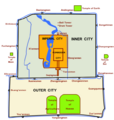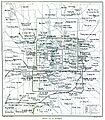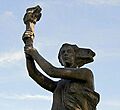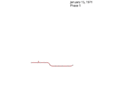History of Beijing facts for kids
The city of Beijing has a long and exciting history that goes back over 3,000 years!
Before China became one big country in 221 BC, Beijing was the capital of ancient states called Ji and Yan. It was an important city in the early Chinese empires like the Qin and Han. Beijing was close to China's northern border, so it became a key place for trade and defense against tribes from the north.
From the 10th to the 13th centuries, nomadic groups like the Khitan and Jurchen came from beyond the Great Wall and made Beijing their capital. Then, in 1279, Kublai Khan made Dadu (which is Beijing today) the capital of his Mongol-led Yuan dynasty. This was the first time all of China was ruled from Beijing.
Since 1279, Beijing has almost always been China's capital. It was the center of power for the Ming dynasty (1421–1644), the Manchu-led Qing dynasty (1644–1912), the early Republic of China (1912–1928), and now the People's Republic of China (1949–present).
Contents
- Ancient Times: Early Humans and Settlements
- Beijing's First Kingdoms and Names
- Beijing in Early Empires
- Liao, Song, and Jin Dynasties: Beijing Becomes a Capital Again
- Yuan Dynasty: The Grand Capital
- Ming Dynasty: Beijing Becomes the "Northern Capital"
- Qing Dynasty: A New Imperial Era
- Republic of China: Changes and Conflicts
- People's Republic of China: Modern Beijing
- See also
- Images for kids
Ancient Times: Early Humans and Settlements
The very first signs of people living in the Beijing area were found in caves at Dragon Bone Hill. This is near a village called Zhoukoudian. Here, Homo erectus (known as Peking Man) lived from about 770,000 to 230,000 years ago. Later, early homo sapiens also lived in these caves from about 27,000 to 10,000 years ago.
In 1996, over 2,000 Stone Age tools and bone pieces were found in downtown Beijing at Wangfujing. These items are about 24,000 to 25,000 years old. You can see them today at the Wangfujing Paleolithic Museum.
Archaeologists have found more than 40 ancient farming villages and burial sites around Beijing. These sites show that farming was common in the area 6,000 to 7,000 years ago.
Beijing's First Kingdoms and Names
The earliest stories about Beijing are mixed with legends. A big battle called the Battle of Banquan might have happened near Beijing about 4,600 years ago. This battle helped unite early Chinese tribes.
About 4,000 years ago, a wise king named Yao built a town called Youdu in the Beijing area. The name You or Youzhou later became one of Beijing's old names.
The first time we have archaeological proof of Beijing's history is around the 11th century BC. This is when the Zhou dynasty took over the Shang dynasty. The Zhou king gave land to nobles, including rulers of the city-states of Ji and Yan.
The city of Ji, called Jicheng, was in the southwest part of what is now Beijing. The capital of Yan was further south. Over time, Yan conquered Ji and moved its capital to Jicheng. Because of this, Beijing is also known as Yanjing (meaning "Yan Capital").
The State of Yan grew into one of the seven major powers during the Warring States period (473–221 BC). To protect itself from northern invaders, Yan built walls along its border. These walls were built over 1,500 years before the famous Ming Great Wall.
In 226 BC, the State of Qin conquered Ji. The Qin ruler then became the First Emperor of a united China in 221 BC.
Beijing in Early Empires
For about 1,000 years, Beijing was a city in the northern part of China's empires. Dynasties that ruled from central China used Beijing to manage trade and military dealings with nomadic groups from the north.
The Qin dynasty divided China into areas called "commanderies." Beijing became the center of Guangyang Commandery. The Qin emperor also had parts of the Great Wall built near Beijing to protect against northern tribes.
The Han dynasty followed the Qin. Beijing remained an important regional center, serving as the capital for Youzhou, a large area that stretched all the way to the Korean Peninsula.
During the Three Kingdoms period, the Kingdom of Wei controlled Youzhou and its capital, Ji. They built irrigation systems to help farming in the area.
Later, during a time of many small kingdoms, Beijing (still called Ji) was controlled by different groups. In 352, the Former Yan Kingdom made Ji its capital for a short time.
When the Sui dynasty reunited China in 589 AD, Youzhou was renamed Zhuojun. The Sui emperor built canals to send troops and food from central China to Zhuojun for wars against Korea. The Tang dynasty continued these wars. In 645 AD, the Tang Emperor Taizong built the Minzhong Temple (now Fayuan Temple) in Beijing to honor those who died in the wars. This is one of the oldest temples in Beijing today.
The Tang dynasty later renamed Zhuojun back to Youzhou. In 755, a military leader named An Lushan started a big rebellion from Youzhou. This rebellion lasted eight years and greatly weakened the Tang dynasty. After the Tang dynasty fell, Youzhou remained independent for a while.
Liao, Song, and Jin Dynasties: Beijing Becomes a Capital Again
Beijing was always important for tribes from the north who wanted to enter China. The city's importance grew a lot from the 10th century when the Khitans, Jurchens, and Mongols invaded China.
Liao Dynasty's Southern Capital
In 938, the Liao dynasty (founded by the Khitan people) renamed Youzhou to Nanjing (meaning "Southern Capital"). It became one of their important secondary capitals. The Liao city was in the southwest part of modern Beijing. Some of Beijing's oldest landmarks, like the Niujie Mosque (built in 996) and the Tianning Temple (built in 1120), are from this time. Under Liao rule, many people moved to the city, and its population grew a lot.
The Song dynasty in central China tried to take back these northern lands. In 979, the Song emperor attacked Nanjing (Youzhou) but was defeated.
In 1120, the Song dynasty teamed up with the Jurchens (who founded the Jin dynasty (1115–1234)) to invade the Liao. The Jurchens quickly captured the Liao capitals. In 1122, the Jin army took Nanjing from the Liao. The city was renamed Yanjing.
Song Dynasty's Brief Rule
In 1123, the Jin dynasty agreed to give Yanjing and other areas to the Song dynasty. But first, the Jurchens looted the city and forced many officials and craftspeople to move to their capital. The Song dynasty's rule over the city, which they renamed Yanshan, was very short.
The Jurchens soon used a small incident as an excuse to invade again. In 1125, Jin forces defeated the Song army and quickly marched on the Song capital, Kaifeng. The Song emperors were captured in 1127, ending the Northern Song dynasty. Yanshan was renamed Yanjing again.
Jin Dynasty's Central Capital
In 1153, the Jin emperor Wanyan Liang moved his capital from the north to Yanjing. He renamed the city Zhongdu (meaning "Central Capital"). This was the first time Beijing became the main capital of a major dynasty!
The Jin dynasty made the city much bigger, expanding it to the west, east, and south. Remnants of Zhongdu's city walls can still be seen today. The famous Lugou Bridge (Marco Polo Bridge) was first built in 1189 during the Jin dynasty. The city's population grew to 400,000 by 1207.
In 1214, the Mongols, led by Genghis Khan, invaded northern China. They besieged Zhongdu. The Jin court agreed to a peace treaty, but then moved their capital further south to Kaifeng. Genghis Khan saw this as a betrayal and attacked Zhongdu again. In 1215, after a long siege where many people starved, Zhongdu surrendered. The city was looted and burned.
One important captive was a Khitan named Yelü Chucai. He convinced Genghis Khan that it was better to tax the people of China than to turn the land into pastures. This advice helped save northern China from total destruction.
Yuan Dynasty: The Grand Capital
Kublai Khan, Genghis Khan's grandson, visited Yanjing in 1261. He liked the area and decided to build his new capital there. In 1271, he started the Yuan dynasty and named his capital Dadu (meaning "Grand Capital"). It was also known as Khanbaliq to the Mongols.
Dadu was built northeast of the old Zhongdu. This new city layout created Beijing's current north-south central axis. Dadu was almost twice the size of Zhongdu. It had strong earthen walls and 11 city gates. The center of Dadu was marked by a pavilion, which is now the Drum Tower.
A special feature of Dadu was a series of lakes in the city's heart, which are now known as the "six seas" of central Beijing. To get more water, a hydrologist named Guo Shoujing built channels to bring water from Yuquan Mountain. The Grand Canal was also extended to Dadu, allowing large amounts of grain to be brought into the city. By 1327, Dadu had 952,000 residents.
The city's streets were laid out in a checkerboard pattern with wide avenues and narrow alleyways called hutongs. Dadu was a very diverse city, with people from all over the Mongol Empire. Famous travelers like Marco Polo visited and wrote about the city.
Ming Dynasty: Beijing Becomes the "Northern Capital"
In 1368, Zhu Yuanzhang started the Ming dynasty in Nanjing. His army captured Dadu, and the city was renamed Beiping (meaning "Northern Peace"). Nanjing became the main capital.
Two years later, Zhu Yuanzhang gave Beiping to his fourth son, Zhu Di, who became the Prince of Yan. Zhu Di built up his military power. After a civil war, Zhu Di took Nanjing in 1402 and became the Yongle Emperor.
In 1403, the Yongle Emperor renamed his home city Beijing (meaning "Northern Capital"). This is the first time the city got its modern name! He started a huge building project to make Beijing his new capital. Many of Beijing's famous buildings, like the Forbidden City and the Temple of Heaven, were built during this time. In 1421, Beijing officially became the main capital of the Ming dynasty.
The Ming dynasty also built most of the Great Wall sections we see today in northern Beijing. The city's population had dropped after the Mongol retreat but grew again. Beijing was one of the largest cities in the world for many years during the Ming dynasty.
In 1449, the Zhengtong Emperor was captured by Mongols. The defense minister, Yu Qian, bravely defended Beijing and refused to pay ransom for the emperor. The city was saved.
In 1553, an Outer City wall was built to protect Beijing's southern suburbs, including the Temple of Heaven. These Ming city walls stood until the 1960s when most were taken down to build the Beijing Subway and the 2nd Ring Road.
European missionaries, like Matteo Ricci, arrived in Beijing in the early 1600s. Ricci became an advisor to the emperor and built the first Catholic church in the city.
By the mid-15th century, the forests around Beijing had disappeared because people used wood for heating. Residents then started using coal, which caused pollution.
In 1643, a terrible epidemic killed 200,000 people in Beijing. This weakened the city's defenses. In 1644, a peasant rebellion led by Li Zicheng captured Beijing. The Chongzhen Emperor took his own life. Soon after, the Manchus, with the help of a Ming general, drove Li Zicheng out of Beijing.
Qing Dynasty: A New Imperial Era
On May 3, 1644, the Manchus took Beijing. They kept many Ming officials and rituals. In October, the child Shunzhi Emperor was moved into the Forbidden City, and Beijing became the new capital of the Qing dynasty. The Qing dynasty ruled China from Beijing for nearly three centuries.
The Qing emperors built beautiful palatial gardens northwest of the city, like the Old Summer Palace and the Summer Palace. Sadly, these were later destroyed by invading Western forces.
The Beijing dialect eventually became the official national language of China during the Qing dynasty. This helped spread the Beijing way of speaking across the country.
Beijing remained a large and important city. The government worked to keep food supplies stable and provided help for those in need. Many of Beijing's oldest businesses, like Tongrentang (a traditional medicine shop) and Quanjude (famous for Peking Duck), started during the Qing era.
In 1860, during the Second Opium War, British and French forces captured Beijing and burned the Old Summer Palace. This forced the Qing government to allow Western countries to have permanent embassies in the city.
In 1900, the Boxer Rebellion broke out, with groups trying to remove foreign influence from China. The Boxers and Qing forces besieged the foreign embassies in Beijing. Foreign armies from eight nations then captured the city, looted it, and forced the Qing government to pay a huge amount of money.
After the Boxer Rebellion, the Qing dynasty tried to make reforms. The old imperial exams were stopped, and Western-style education was introduced. Peking University was founded in 1898, and Tsinghua University was established in 1911. These universities would become very important for China's future.
The first railways in Beijing were built in the late 1800s and early 1900s, often with foreign help. These railways connected Beijing to other major cities and helped the city grow as a transportation hub.
Republic of China: Changes and Conflicts
The Qing dynasty fell in the Xinhai Revolution of 1911. Beijing remained the capital of the new Republic of China under former Qing general Yuan Shikai.
In 1928, the Chinese Nationalists reunited the country and moved the capital to Nanjing. Beijing was then renamed Beiping (meaning "Northern Peace").
In 1937, a clash between Chinese and Japanese troops near Beiping started the Second Sino-Japanese War. Japanese forces occupied the city and renamed it Beijing again, making it the capital of their puppet government in northern China.
During the war, many universities in Beijing moved to safer areas. After Japan surrendered in 1945, the city returned to Chinese rule and was renamed Beiping again.
The Chinese Civil War then broke out between the Nationalists and Communists. In 1949, the city was peacefully handed over to Communist control. It was renamed Beijing once more and became the capital of the People's Republic of China.
People's Republic of China: Modern Beijing
On October 1, 1949, Mao Zedong announced the founding of the People's Republic of China from Tiananmen Gate. Beijing became the national capital again. The city grew hugely in size and population over the next decades.
Beijing was transformed to fit the ideas of a socialist state. Tiananmen Square was made much larger for big public gatherings. Many famous buildings, like the Great Hall of the People and the National Museum of China, were built by 1959. Many old neighborhoods were replaced by factories and apartment buildings. The old city walls were taken down in the 1960s to build the Beijing Subway and the 2nd Ring Road.
During the Korean War, Beijing hosted its first big international meeting, the Asia and Pacific Rim Peace Conference. The new neighborhood of Hepingli (Place of Peace) was named after this conference.
Beijing became a major center for education and research. Many universities were opened or moved to the city.
From 1949 to 1958, Beijing's area grew a lot as it took in land from the surrounding Hebei Province. By 1958, the city's population reached over 6 million.
The Great Leap Forward and its Challenges
In 1958, Mao Zedong started the Great Leap Forward, a big plan to quickly develop China's economy. In Beijing, people were encouraged to make steel in small furnaces at home. City walls were even torn down to use their bricks for these furnaces.
A strange part of this campaign was trying to get rid of "Four Pests", including sparrows, which were blamed for eating grain. Millions of sparrows were killed, but this led to more insects, which caused problems for crops.
Food shortages became a big problem, and many people in Beijing faced hunger. The government had to send some residents to the countryside because the city couldn't support them.
The Cultural Revolution and its Impact
The Cultural Revolution, a big social and political movement started by Mao Zedong, began and ended in Beijing. It had a huge impact on the city and the country.
Mao encouraged young people from Beijing's universities and high schools to join his campaign. These students formed groups called "Red Guards". They were told to attack "bourgeois" (middle-class) elements in society.
The Red Guards ransacked homes, destroyed cultural items, and criticized people they saw as enemies of the revolution. Many historical sites were damaged or destroyed. Most places of worship were closed. The Forbidden City was protected by Premier Zhou Enlai. Many streets were renamed with revolutionary slogans.
By 1967, the Red Guards started fighting among themselves. In 1968, Mao sent the military to take control, and many Red Guards were sent to the countryside for "reeducation."
The Cultural Revolution also increased tensions with the Soviet Union. Beijing residents built a large underground bunker system to protect against a possible nuclear attack.
In 1972, Richard Nixon made a historic visit to Beijing, which began to improve relations between China and the United States. This led to more Western businesses and embassies opening in Beijing.
After Premier Zhou Enlai died in 1976, many people in Beijing showed their respect by placing wreaths and poems at the Monument to the People's Heroes in Tiananmen Square. This protest, known as the April 5th Movement, was against the radical leaders who were still in power.
Mao Zedong died in Beijing in September 1976. Less than a month later, the radical leaders were arrested, ending the Cultural Revolution. Deng Xiaoping then rose to power and started economic reforms.
1980s: Reforms and Protests
After the Mao era, Beijing's city planning changed. The city aimed to become a center for international exchange, science, technology, culture, and education. It would no longer focus on heavy industry. New ring roads were built around the city.
A short period of political openness called the Beijing Spring happened in 1978. People posted their ideas and criticisms on a wall called the Democracy Wall in Xidan. Some called for more political freedom. However, the government soon restricted these public postings and gatherings.
Tiananmen Square Protests of 1989
In the spring of 1989, student-led protests in Tiananmen Square gained wide support from Beijing residents. These protests attracted worldwide attention.
The protests began after the death of Hu Yaobang, a liberal leader. Students gathered to mourn him and demand reforms like more freedom of the press and an end to corruption. Thousands of students went on a hunger strike in Tiananmen Square, attracting huge crowds and international media.
On May 19, martial law was declared. On the night of June 3 and early morning of June 4, the military advanced on the city. Troops opened fire on protesters, resulting in many deaths and injuries. The government officially called it a "counterrevolutionary rebellion." The events of June 4 remain a sensitive topic in China.
1990s: Growth and Challenges
In 1990, Beijing's population reached over 10 million. The city hosted the 1990 Asian Games in 1990, building new venues and infrastructure.
The 1990s saw very fast economic growth in Beijing. Farmland was developed into new residential and business areas. Modern highways and tall buildings were built. Foreign investment helped Beijing become a very modern and wealthy city.
In 1995, a major corruption scandal shook the city government. Also in 1995, two bombs exploded on Beijing buses, which were blamed on separatists.
In 1999, over 10,000 Falun Gong practitioners gathered outside Zhongnanhai to protest. This led to the government banning Falun Gong. Later that year, students protested outside the U.S. Embassy after NATO bombed the Chinese Embassy in Yugoslavia.
On October 1, 1999, Beijing celebrated the 50th Anniversary of the People's Republic of China with a big parade.
2000s: Olympics and Urban Development
In 2000, Beijing's population reached over 13.5 million. On July 13, 2001, Beijing was chosen to host the 2008 Summer Olympics and Paralympics Games.
The city spent a huge amount of money (about US$36 billion) to prepare for the Olympics. They built new sports venues like the "Bird's Nest" stadium and the "Water Cube" aquatics center. They also built new highways, six subway lines, and a new airport terminal. Efforts were made to improve the environment.
In March 2003, the Severe Acute Respiratory Syndrome (SARS) epidemic spread to Beijing. The city was hit hard, with many cases and deaths. Schools and entertainment places were closed. The epidemic eventually subsided.
Rapid growth also brought problems like heavy traffic and pollution. By 2008, pollution was a big concern, especially with the Olympics coming. The city worked to reduce pollution by changing factories and power plants to burn cleaner coal.
The 2008 Summer Olympics opened on August 8, 2008, with a grand ceremony. It was the largest international event in Beijing's history, with athletes and leaders from many countries. China won the most gold medals for the first time.
On October 1, 2009, a military parade and concert were held to celebrate the 60th anniversary of the People's Republic of China.
2010s: Economic Boom and Challenges
After the Olympics, Beijing's economy continued to grow very quickly. By 2013, Beijing had more headquarters of Fortune Global 500 companies than any other city in the world. It also had many billionaire residents.
This rapid growth caused property prices to rise very high, making Beijing one of the most expensive cities in China. The city government tried to control prices and limit home ownership.
In November 2014, Beijing hosted the APEC Economic Leaders' Meeting, a big meeting of leaders from Asia-Pacific countries.
On September 3, 2015, a large military parade was held to celebrate the 70th anniversary of the victory in World War II.
In November 2017, a fire in a Beijing neighborhood led the government to demolish many "illegal structures." This caused millions of migrant workers to leave the city.
See also
- City of Ji
- Youzhou
- Khanbaliq (Dadu)
- Beiping
- Peking
Images for kids
-
The Upper Cave on Dragon Bone Hill in Zhoukoudian where remains of the Peking Man were found.
-
For several centuries before the unification of China in 221 BC, Beijing was the capital of the State of Yan. Bronze Yan helmet (above), sword-shaped Yan coins (right), and the Gefujia yun (far right), all from the Capital Museum.
-
Celadon figurines from the Wei Kingdom of Three Kingdoms Period, discovered in Balizhuang of Haidian District, now located in the Haidian Museum.
-
The Tanzhe Temple in Western Hills, founded in 307 in the Jin dynasty (266–420), is the oldest Buddhist temple in Beijing.
-
The Fayuan Temple in Xicheng District was first established by Emperor Taizong of the Tang dynasty in 645
-
The mysterious Guyaju cave dwellings in Yanqing County are believed to be abode of the Xi people during the Tang and Five Dynasties period.
-
The Lugou Bridge, first built in 1189, dates to the Jin (金) dynasty (1115–1234).
-
The Yinshan Pagoda Forest in Yanqing became a Buddhist sanctuary in the early 9th century. Of the seven pagodas standing today, five date to the Jin (金) dynasty (1115–1234) and two to the Yuan.
-
Kublai Khan made Beijing the capital of Yuan dynasty. (Portrait by Araniko in Dadu in 1294. Collections of the National Palace Museum)
-
The Confucius Temple in Dongcheng District, firstly built in 1302 under Temür Khan (Emperor Chengzong) is the second largest in China. The temple houses 198 stone tabulets engraved with the names of 51,624 jinshi scholars of the Yuan, Ming and Qing dynasties.
-
Shichahai, part of the Old Beijing section of the Grand Canal
-
The Yongle Emperor moved the capital of the Ming dynasty from Nanjing to Beijing in 1421. He commissioned the Forbidden City, which was built from 1406 to 1420.
-
Plan of Beijing showing the Forbidden City inside the Imperial City, as well as the Inner and Outer Cities.
-
The Hall of Supreme Harmony of the Forbidden City
-
Beijing's Ancient Observatory, established in 1442, as depicted by Jean Baptiste Bourguignon d'Anville in 1737. In the Qing dynasty, Jesuit directors of the observatory, Johann Adam Schall von Bell and Ferdinand Verbiest, built many of the instruments.
-
Dorgon preserved trappings of imperial power including the bureaucracy, rituals and palaces, and moved the Qing capital to Beijing. In so doing, he positioned the Qing as the political heir to the Ming and legitimate ruler of China. Above, Qing imperial procession at the Forbidden City depicted in an 18th-century Jesuit painting.
-
1888 water color pictorial map of the Summer Palace
-
Foreign armies of the Eight-Nation Alliance assemble inside the Forbidden City after capturing Beijing.
-
The Imperial Examination Hall (Gongyuan) in 1909. For centuries, students flocked to the capital each year to take the imperial examination, and spent days in densely packed cubicles. Highest scorers received degrees and government positions. The exams were abolished in 1905 as part of the education reforms.
-
Faculty of the Imperial University of Peking, the institutional predecessor of Peking University.
-
Grand Auditorium of Tsinghua University, established by the Boxer Indemnity Scholar Program.
-
Regent Prince Chun (seated) asked Yuan Shikai to quell the Wuchang Uprising in October 1911, but agreed to end the Qing dynasty in February 1912 to secure the safety of the royal family. His son, Puyi (standing) was the Last Emperor.
-
Yuan Shikai seized control of the Xinhai Revolution by extracting the abdication of the imperial court and the provisional presidency of the Republic.
-
Sun Yat-sen founded the new Republic but agreed to give the provisional presidency to Yuan Shikai. Sun then formed the Chinese Nationalist Party in Beijing, which won the first national elections in 1913.
-
Yuan Shikai was inaugurated as the provisional president of the newly established Republic of China in Beijing on March 10, 1912. He maneuvered to keep the capital of the new republic in Beijing where his Beiyang Army held sway.
-
Yuan based his office and residence in the Zhongnanhai Compound next to the Forbidden City. The New China Gate was built as the southern entrance to Zhongnanhai during Yuan's reign. Above: honor guard accompanying a foreign delegation in 1924.
-
The first elected National Assembly was dissolved by Yuan Shikai in 1914, reconvened by Duan Qirui in 1916, dissolved by Zhang Xun during the imperial restoration in 1917, and reconvened again in 1922. (Pictured here on August 1, 1916)
-
Peking University (shown here the "Red Building" on what is now May 4th Boulevard), played a prominent role in the Movement.
-
Shortly after taking Beijing during the Northern Expedition, Nationalist Party leaders led by Chiang Kai-shek gathered at the Temple of Azure Clouds on July 6, 1928, to pay homage to Sun Yat-sen. Sun's tomb and the seat of national government were both moved to Nanjing. Beijing was renamed Beiping. Front row from left: Bai Chongxi, Ma Sida, Ma Fuxiang, Yan Xishan, Wu Zhihui, Chiang, Chen Diaoyuan, Zhang Zuobao, and He Chengjun.
-
Street scene after the introduction of street trams in 1921. Rickshaws were also common.
-
Left:The Executive Headquarters of U.S. General George C. Marshall's Mission to China (1945–1947) near the Peking Union Medical College in Beiping with a "Committee of Three" to mediate disputes between the Chinese Nationalists and Communists. The mission brokered a truce in 1946 and but failed to create a coalition government and prevent the outbreak of civil war.
-
Right: A large portrait of Chiang Kai-shek was displayed above Tiananmen Gate during the Civil War.
-
Left: After Nationalist Commander Fu Zuoyi agreed to hand over Beiping without a fight, the People's Liberation Army entered the city on February 3, 1949. Pictured is the military procession toward Qianmen.
-
Left:From atop Tiananmen Gate, Mao Zedong, proclaimed the founding of the People's Republic of China on October 1, 1949, and Beijing again became the capital of China.
-
Right: Beijing middle school students attended the ceremony in Tiananmen Square.
-
Mao-era slogans adorn the walls of Plant No. 798, built in 1952 with East German assistance. In 2002, the plant's bauhaus-style warehouses were converted into 798 Art Zone, a modern art community.
-
A parade on Chang'an Avenue promoting the Great Leap Forward, People's Communes and the General Mass Line of the Party.
-
Students at Beijing Normal University writing big-character posters denouncing Liu Shaoqi.
-
Big-characters posted on the campus of Peking University.
-
Mao Zedong and Lin Biao surrounded by rallying Red Guards in Beijing.
-
Tiananmen Square on September 15, 1966, the occasion of Chairman Mao's third of eight mass rallies with Red Guards in 1966.
-
A 1968 city map showing streets and landmarks renamed during the Cultural Revolution. For example, Andingmen Inner Street became "Great Leap Forward Road"; Taijichang Street became the "Road for Eternal Revolution"; Dongjiaominxiang, the main street of the former Legation Quarter, was renamed "Anti-Imperialist Road"; Beihai Park was renamed "Worker-Peasant-Soldier Park" and Jingshan Park became "Red Guard Park". Most of the Cultural Revolution-era name changes were later reversed.
-
Air Force One at the Capital Airport.
-
Richard and Pat Nixon at the Badaling Great Wall.
-
The diplomatic opening was facilitated by "ping pong diplomacy", and leaders of the two countries watched a table tennis exhibition at the Capital Indoor Stadium.
-
The Monument to the People's Heroes was erected in Tiananmen Square in 1958 to commemorate the martyrs of revolutions in modern Chinese history.
-
Mourners of Zhou Enlai laid thousands of floral wreaths at and around the foot of the monument during the April 5th Movement of 1976. The Monument later became the gathering point student leaders during the 1989 Tiananmen Square Protests. Behind the Monument is the Mao Zedong Mausoleum, completed in 1977.
-
The New China Gate to Zhongnanhai on Chang'an Avenue between Tiananmen Square and Xidan. Shortly after Hu Yaobang's death in April 1989, university students staged a silent sit-in outside the gate, demanding dialogue with the leadership. The sit-in was dispersed by police and provoked the first large-scale student march on April 21.
-
A bronze replica of the Goddess of Democracy statue in Washington, D.C.. The original plaster of paris statue, created by students and teachers of the Central Academy of Arts, stood in Tiananmen Square for six days from May 30 to June 4, 1989, and was torn down by the military enforcing martial law.
-
The Hall of Tanks inside the Military Museum of the Chinese People's Revolution, on Chang'an Avenue in western Beijing. At nearby Muxidi on the night of June 3, soldiers of the 38th Army opened fire on civilian demonstrators. The following morning, the 28th Army was surrounded at Muxidi by angry residents showing bloody clothing from the massacre the night before. The 28th Army's commanders defied orders to counterattack and instead had troops retreat into the museum, leaving their vehicles to be burned by protesters outside.
-
The East Building of the Beijing Hotel, built in 1974, was the tallest building in city until 1984. On June 5, 1989, from the hotel's porches overlooking Chang'an Avenue, foreign press took the iconic image of the lone protester standing in front a column tanks.
-
On April 25, 1999, Falun Gong practitioners assembled outside the Zhongnanhai compound on to protest criticism of the sect in the state media.
-
From 2001 to 2008, a clock on the east side of Tiananmen Square, counted down to the opening of the XXIX Olympiad. The Dancing Beijing features Beijing's "jing (京)" character styled to resemble a man running. Nearly all Olympic venues are located in the northern half of the city.
-
The Olympic Green in 2006 with the National Stadium ("Bird's Nest") and Aquatics Center ("Water Cube") under construction.
-
Terminal 3 of Capital Airport, was the world's largest when it opened on Feb. 29, 2008.
-
Smog diminishes visibility in Beijing. From atop Jingshan, the Forbidden City and buildings on Tiananmen Square are obscured.
-
Yao Ming carries the Olympic torch at Tiananmen.
-
Usain Bolt sets world record in 100 m dash.
-
Beach volleyball gold medalist Kerri Walsh thanks Beijing volunteers.
-
From the rostrum atop Tiananmen Gate, Chinese paramount leader Xi Jinping presided over the parade commemorating the 70th anniversary of the victory in World War II, with guests of honor Russian President Vladimir Putin and South Korean President Park Geun-hye.



